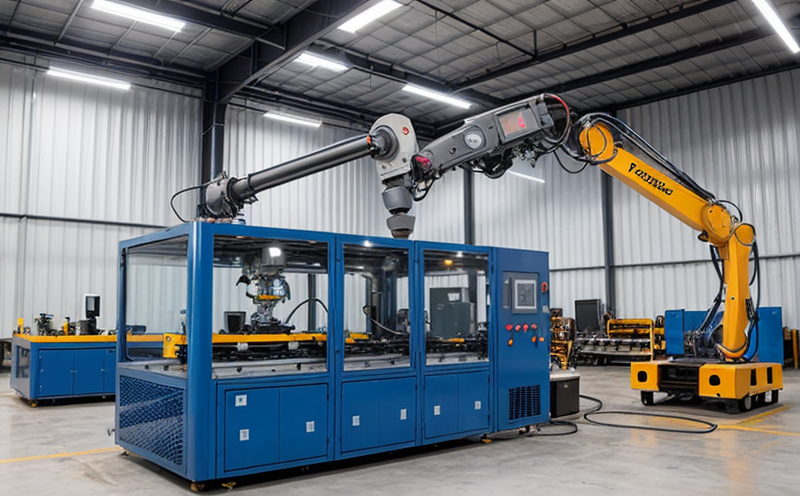ASTM F3171 Mobile Robot Navigation Accuracy Testing
The ASTM F3171 standard is a cornerstone in ensuring the safety and reliability of mobile robots used in industrial environments. This test assesses the accuracy of navigation systems, focusing on the robot's ability to traverse predefined paths with precision and consistency. Industrial robotics and automation are integral to modern manufacturing processes, where efficiency and accuracy are paramount for maintaining production schedules and reducing errors.
The ASTM F3171 standard applies to mobile robots designed for various industrial applications, including but not limited to logistics, warehousing, and factory automation. The test evaluates the robot's ability to navigate a series of points with specified tolerances, ensuring that the robot operates safely and efficiently within its designated area.
The ASTM F3171 test involves several critical steps: - Calibration: Ensuring the robot’s sensors are accurately calibrated. - Path Definition: Defining a precise path for the robot to follow. - Execution: The robot navigates the predefined path. - Measurement: Recording and analyzing the deviations from the expected path.
The accuracy of mobile robots is crucial in industrial settings. Inaccurate navigation can lead to collisions, misplacement of materials, or even safety hazards. By adhering to ASTM F3171 standards, manufacturers ensure that their robotic systems perform consistently and safely.
Compliance with this standard also helps companies meet regulatory requirements and enhances their reputation for quality and reliability. This is particularly important in industries where precision is critical, such as pharmaceuticals or electronics manufacturing.
The ASTM F3171 test is not just about the robot's performance; it also evaluates the robustness of the navigation system. This includes assessing how well the robot can handle unexpected situations like changes in lighting conditions or obstacles. The standard ensures that mobile robots are capable of operating under a variety of real-world conditions, which is essential for their effective deployment.
In summary, ASTM F3171 testing is vital for ensuring the safety and reliability of industrial robotics systems. By adhering to this standard, manufacturers can ensure that their robotic solutions meet the highest industry standards and are capable of operating efficiently in complex environments.
Why It Matters
The importance of ASTM F3171 testing cannot be overstated. In industrial settings, robots must operate with precision to minimize errors and ensure safety. Any deviation from the expected path can lead to significant issues such as damage to equipment or products, increased downtime, and even safety hazards for workers.
Compliance with ASTM F3171 ensures that mobile robots are capable of navigating their environments accurately and consistently. This is particularly critical in industries like manufacturing, where the cost of errors can be substantial. By adhering to this standard, companies demonstrate a commitment to quality and reliability, which can enhance their reputation and competitiveness.
Moreover, ASTM F3171 testing helps manufacturers identify and address potential issues early in the development process. This proactive approach not only improves product performance but also reduces the risk of costly recalls or accidents. In an era where safety is a top priority, compliance with this standard is essential for maintaining trust with customers and stakeholders.
Ultimately, ASTM F3171 testing ensures that industrial robots are reliable and capable of operating safely in complex environments. By adhering to this standard, companies can ensure that their robotic solutions meet the highest industry standards and are fit for purpose.
Quality and Reliability Assurance
The ASTM F3171 standard plays a crucial role in ensuring the quality and reliability of mobile robots used in industrial settings. This test is designed to assess the accuracy of navigation systems, focusing on the robot's ability to traverse predefined paths with precision and consistency.
By adhering to ASTM F3171 standards, manufacturers can ensure that their robotic solutions meet the highest industry standards and are capable of operating efficiently in complex environments. This is particularly important for industries where precision is critical, such as pharmaceuticals or electronics manufacturing.
The standard ensures that mobile robots are capable of navigating their environments accurately and consistently. This includes assessing how well the robot can handle unexpected situations like changes in lighting conditions or obstacles. The ASTM F3171 test helps manufacturers identify and address potential issues early in the development process, improving product performance and reducing the risk of costly recalls or accidents.
In summary, ASTM F3171 testing is vital for ensuring that industrial robots are reliable and capable of operating safely in complex environments. By adhering to this standard, companies can ensure that their robotic solutions meet the highest industry standards and are fit for purpose.
Use Cases and Application Examples
The ASTM F3171 standard is widely applicable in various industrial settings where mobile robots play a crucial role. One of the primary use cases is in logistics and warehousing, where robots are used to efficiently move materials from one location to another. In this context, accuracy is paramount to avoid delays and ensure that tasks are completed on time.
In factory automation, mobile robots can be used for quality control inspections or to transport parts between different stations. Here, the robot's ability to navigate complex pathways with precision ensures that production processes run smoothly and efficiently. Another application is in the pharmaceutical industry, where accuracy in robotic navigation is essential for ensuring product safety and compliance.
Compliance with ASTM F3171 standards can also enhance a company’s reputation for quality and reliability. This is particularly important in industries where precision is critical, such as electronics manufacturing or aerospace engineering. By adhering to this standard, companies demonstrate their commitment to excellence and are better positioned to meet regulatory requirements.
Ultimately, ASTM F3171 testing ensures that industrial robots are reliable and capable of operating safely in complex environments. This is vital for maintaining trust with customers and stakeholders, as well as ensuring the safety and efficiency of operations.





